8 Lovely Marigold Varieties To Try: ‘I Wouldn’t Want My Allotment To Be Without Them’

ANNUALS > MARIGOLDS > VARIETIES
Reviewed By PETER LICKORISH

Peter is a Horticulture Lecturer and self-employed Horticulturist, with a passion for diverse areas of the industry - from garden design to the science behind plant growth and propagation. He has completed the Royal Horticultural Society’s Master of Horticulture (MHort) Award and lectures on RHS courses at Bedford College.
Contributions From ELLEN MARY

Ellen Mary is a Gardener, Writer and Presenter, as well as being the co-host of the Plant Based Podcast. She has delivered talks at many RHS Flower Shows (including Chelsea) and written for publications such as The Times and The Telegraph. Ellen is also the founder of People, Plants, Wellbeing - a nature therapy business that runs retreats in nature.
IN THIS GUIDE
MARIGOLDS GUIDES
Genus Tagetes includes within it about 50 species and several hundred hybrids and cultivars.1The Editors of Encyclopaedia Britannica. (1998f, July 20). Marigold. Encyclopedia Britannica. Retrieved March 21, 2023, from https://www.britannica.com/plant/marigold
Among the 50 species, the two key ones, from a flora-centric viewpoint, are Tagetes erecta and Tagetes patula.
T. erecta is informally called ‘African Marigold’ and T. patula, ‘French Marigold’.2Tagetes erecta | African marigold. (n.d.). Royal Horticultural Society. Retrieved March 21, 2023, from https://www.rhs.org.uk/plants/151627/tagetes-erecta/details
“I think the humble French Marigold is so underrated and reminds me of my uncle’s organic kitchen garden, so I always grow these and save seeds,” shares Garden Writer Ellen Mary.
“I wouldn’t want my allotment to be without them.”
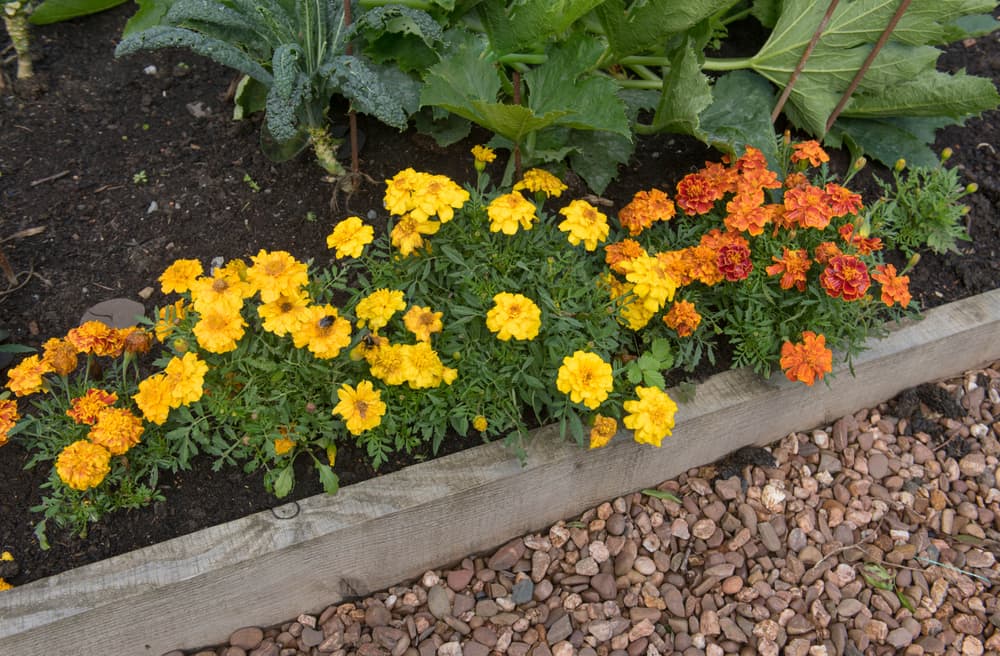
This nomenclature may justifiably cause Latin Americans to feel aggrieved because both species originate from Central and South America!3Marigold History. (2021, May 21). Burpee. Retrieved March 21, 2023, from https://www.burpee.com/blog/marigold-history_article10006.html
At least T. lucida is known as ‘Mexican Marigold’ but that’s scant consolation.4Tagetes lucida. (n.d.). North Carolina Extension Gardener Plant Toolbox. Retrieved March 21, 2023, from https://plants.ces.ncsu.edu/plants/tagetes-lucida/
Other species include T. lucida and T. tenuifolia; their flowers are also used, though less frequently so, for ornamental and celebratory purposes.
The increasingly popular hybrid T. erecta x T. patula and the F1 Zenith hybrid deserve a mention as these combine the best qualities of either species in particularly robust and trouble-free (relatively) new ‘semi-species’.
All of these Tagetes species fall under Family Asteraceae.
As such, one must bear in mind that technically Marigold ‘flowers’ are, in fact, composite flowers, flowerheads, or capitula, and the ‘petals’ are actually ray florets.
Tagetes leaves come in varying shades of green depending on the variety.
What they have in common is that they are heavily lobed or divided, and are pinnate.
They occur in an alternate or opposite arrangement.
Appearance
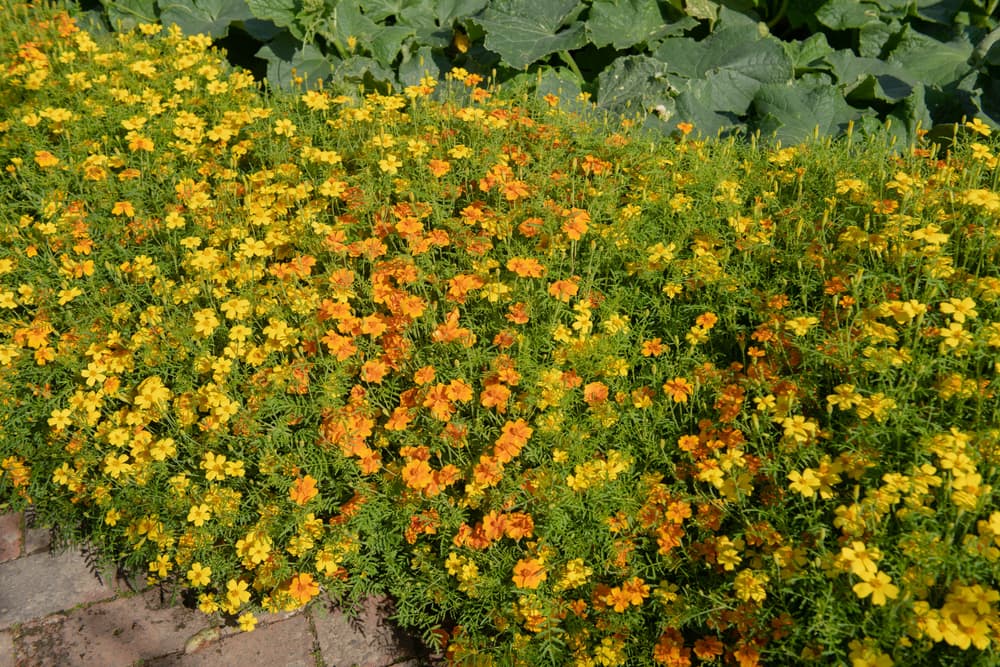
T. erecta or ‘African Marigold’ varieties vary widely in height, ranging from 30-120cm with a majority hovering around 90cm.
Some varieties have an upright habit while others have a bushy one, and their spread ranges from 30-60cm.
Flowerheads are up to 12cm across, are mostly double but sometimes single, are quite dense, and resemble a pompom.
The colour varies from pale yellow to orange.
“The closest colour to white I’ve found in a large flowering marigold is Tagetes erecta ‘Vanilla’,” shares Peter Lickorish, a Master Horticulturist.
“I was really stunned when I first saw it because of the sharp contrast between its cream flowers and dark foliage, and I was struck by how unusual it was.
“It is far paler than Tagetes patula ‘Alumia Vanilla Cream’, which is unusual in its own right.
“‘Vanilla’ opens up so many options for using marigolds with cooler colours in bedding displays, such as the blues, pinks and purples of Petunias and Lobelia, which might clash with traditional golden marigold tones.”
1) T. erecta ‘Big Top Yellow’

T. erecta ‘Big Top Yellow’ rises to about 90cm and has a bushy habit.
It produces flowers from early summer into autumn.
The densely-packed rounded flowerheads are about 8cm wide and are an intense sunny hue of yellow.
2) T. erecta ‘Inca I Orange’
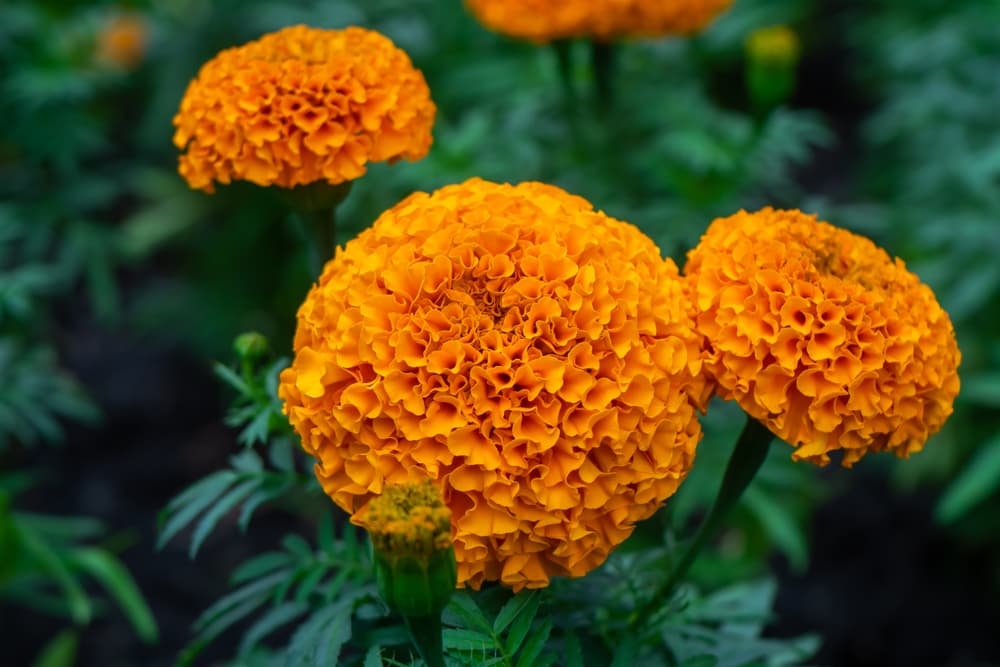
One of the less common types that is both a dwarf to about only 30cm and with an upright habit.
This productive variety bears blooms from summer until late autumn.
The pompom-like flowerheads are 8-9cm across and are that classic golden-orange hue that is usually associated with Marigolds.
3) T. erecta ‘Kushi Mix’
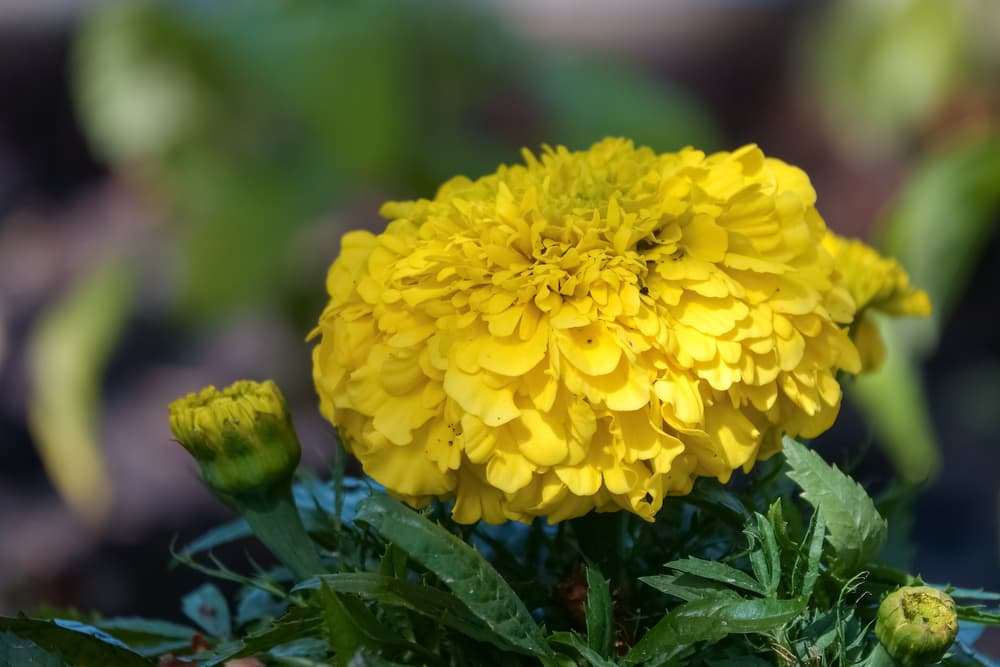
Has dimensions plumb in between the above two varieties with a height of 75cm and spread of about 50cm.
It is a new variety from India that is considered to be robust and weather-resistant – the flowerhead will tolerate damp and wet.
This variety is a mix, and colours include different shades of yellow, gold and orange.
4) T. patula

Varieties usually range from 20-30cm with a spread of 15-25cm.
They have a bushy habit.
Their smaller flowerheads are about 5cm across, and occur in single form as well as double.
Their colours range from a deep yellow to red.
5) T. patula ‘Alumia Vanilla Cream’
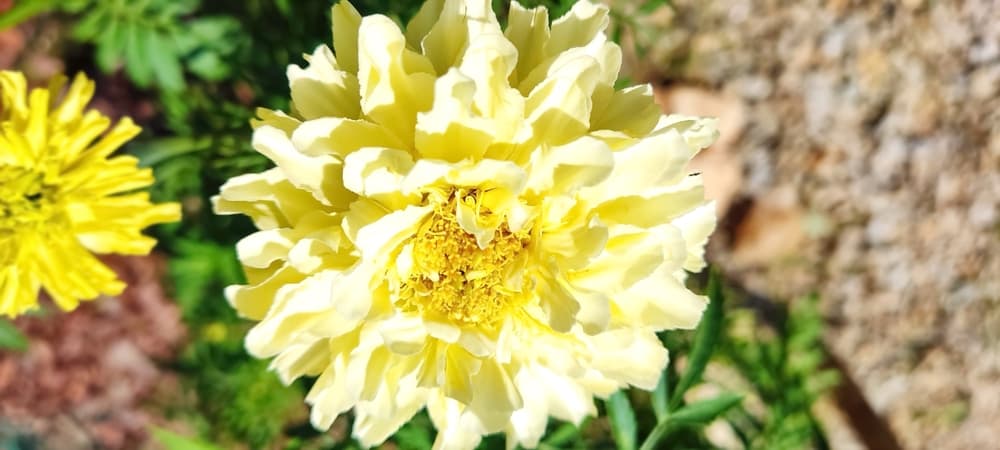
T. patula ‘Alumia Vanilla Cream’ grows to 30cm with a proportional, bushy habit. Its long flowering season extends from late spring well into autumn.
The semi-double flowerheads are quite big for T. patula at 6-7cm.
In an amusing coincidence, this French Marigold is in the exact hue of French Vanilla ice cream!
6) T. patula ‘Strawberry Blonde’
Attains a height of only about 25cm and has a bushy habit.
It too has a very long flowering season stretching from mid-spring deep into autumn.
The flowers are only 5cm across but they make up for it with their colours.
Some flowers open in shades of deep pink and rose and mature to yellow; others retain salmon, rose, and russet hues.
7) T. patula ‘Safari Scarlet’
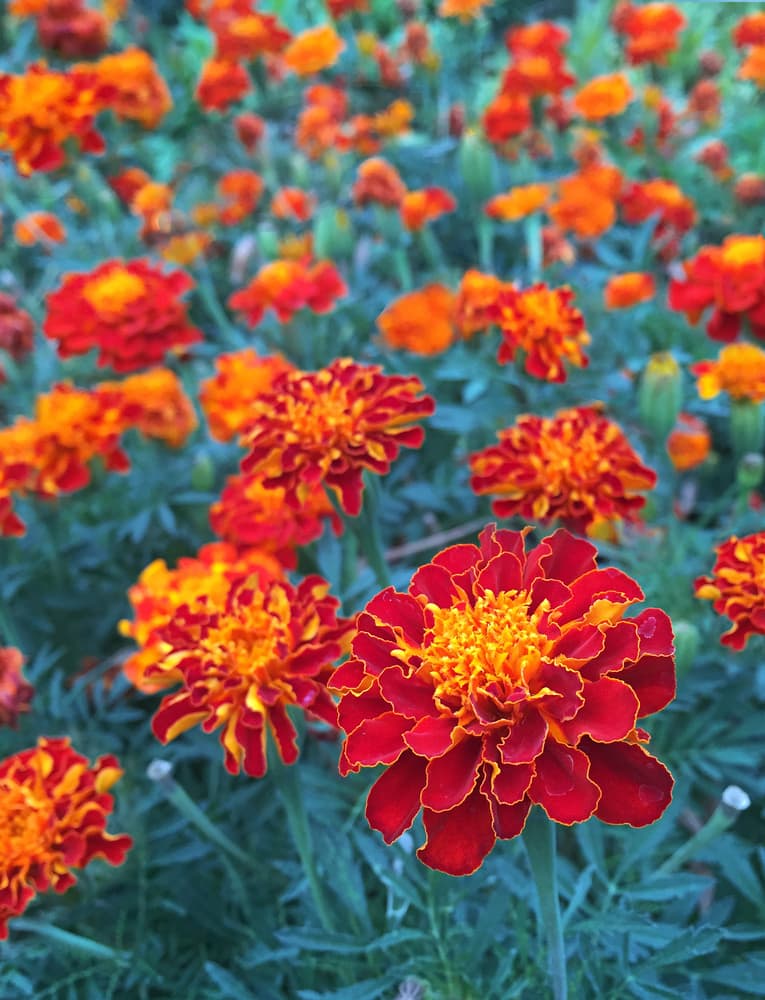
‘Safari Scarlet’ is another dwarf variety that reaches about 25cm; it has a finely-branched and bushy habit.
It produces blooms from mid-spring to late autumn, and they are gorgeous.
The double but not dense flowers are a rich mahogany orange to scarlet with golden-yellow edging on each petal.
This variety has been awarded the RHS Award of Garden Merit.5Tagetes patula “Safari Scarlet.” (n.d.). Royal Horticultural Society. Retrieved March 21, 2023, from https://www.rhs.org.uk/plants/106265/i-tagetes-patula-i-safari-scarlet-(safari-series)/details
8) T. F1 ‘Zenith Mixed’
Zenith F1 series varieties combine the compact size and bushy habit of Tagetes patula with the larger flowerheads of Tagetes erecta.
They have a height and spread of 30-35cm, often with a mounded form.
The flowerhead is 7-8cm across as a minimum for most cultivars in the Zenith series.
Because these hybrids cannot set seed they continue producing flowers well into autumn.
Even by Marigold’s lofty standards this series’ cultivars are floriferous.
Marigold ‘Zenith Deep Orange’ features large double flowerheads of a perfect, rich orange.
Marigold ‘Zenith Red’ features large, very dense, flowerheads in vermilion to red.
References
- 1The Editors of Encyclopaedia Britannica. (1998f, July 20). Marigold. Encyclopedia Britannica. Retrieved March 21, 2023, from https://www.britannica.com/plant/marigold
- 2Tagetes erecta | African marigold. (n.d.). Royal Horticultural Society. Retrieved March 21, 2023, from https://www.rhs.org.uk/plants/151627/tagetes-erecta/details
- 3Marigold History. (2021, May 21). Burpee. Retrieved March 21, 2023, from https://www.burpee.com/blog/marigold-history_article10006.html
- 4Tagetes lucida. (n.d.). North Carolina Extension Gardener Plant Toolbox. Retrieved March 21, 2023, from https://plants.ces.ncsu.edu/plants/tagetes-lucida/
- 5Tagetes patula “Safari Scarlet.” (n.d.). Royal Horticultural Society. Retrieved March 21, 2023, from https://www.rhs.org.uk/plants/106265/i-tagetes-patula-i-safari-scarlet-(safari-series)/details

